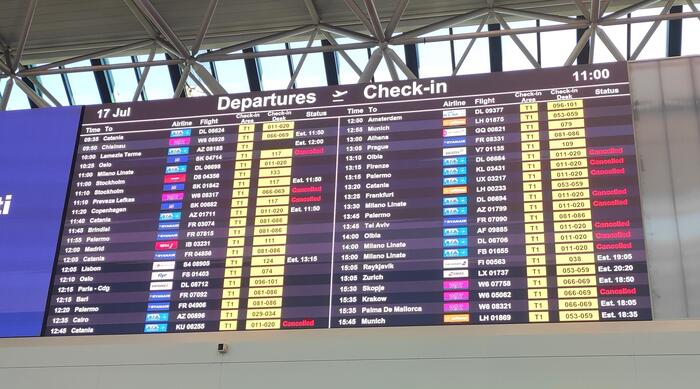Scioperi Italia: Il Governo Interverrà? [Breaking News]
Editor’s Note: Protests and strikes are escalating across Italy. Will the government intervene? This article analyzes the situation, key players, and potential outcomes.
Why This Matters: The Impact of Italian Strikes
Italy is facing a wave of strikes impacting various sectors, from transportation to public services. This article examines the escalating situation, its potential economic and social consequences, and the government's likely response. Understanding the dynamics of these labor actions is crucial for businesses operating in Italy, Italian citizens, and international observers tracking political and economic stability in the Eurozone. Key themes to be explored include the demands of the striking workers, the government's potential responses, and the broader implications for Italy's economic future. This developing situation requires careful monitoring.
Key Takeaways
| Point | Description |
|---|---|
| Strike Scope | Nationwide impact across multiple sectors. |
| Key Demands | Wage increases, job security, and pension reform are central demands. |
| Government Response | Potential for intervention through negotiation or legislative action. |
| Economic Impact | Disruption to supply chains, tourism, and overall economic productivity. |
| Public Opinion | Significant public support and concern regarding the ongoing strikes. |
Scioperi Italia: A Nation at a Crossroads
The recent surge in strikes across Italy represents a significant challenge to the current government. These actions, fueled by rising inflation and concerns about worker rights, are disrupting daily life and raising concerns about the country's economic stability. The widespread nature of these protests underscores the depth of discontent among workers across numerous sectors. This is not simply a localized issue; it's a national phenomenon reflecting broader anxieties about the economic future.
Key Aspects of the Italian Strikes
- Transportation: Significant disruptions to rail, air, and public transport are affecting commuters and travelers alike.
- Public Services: Healthcare, education, and other essential services face potential interruptions.
- Manufacturing: Production slowdowns and potential supply chain disruptions are causing concern for businesses.
Detailed Analysis of the Strikes
The strikes are largely driven by demands for substantial wage increases to offset the impact of inflation. Workers are also calling for stronger job security measures and reforms to the pension system. The government faces a difficult balancing act: addressing worker concerns without triggering further economic instability. Comparisons to previous periods of significant labor unrest in Italy are relevant in understanding potential government responses and outcomes. The scale and intensity of these strikes are unprecedented in recent years, indicating a heightened level of frustration and a potential shift in labor relations dynamics.
Interactive Elements
The Role of Unions in the Italian Strikes
The powerful Italian trade unions are playing a central role in organizing and coordinating these strikes. Their influence on the government's response is substantial. Factors influencing the unions' strategies include public support, the government's willingness to negotiate, and the potential long-term impact on the Italian economy. Risks associated with prolonged strikes include further economic hardship, social unrest, and damage to Italy's international reputation. Mitigation strategies involve open dialogue between the government, unions, and employers, seeking compromise and balanced solutions. The long-term impacts could include significant legislative changes or potential shifts in power dynamics within the labor movement.
Potential Government Interventions
The Italian government has several options: negotiation with unions, offering economic stimulus packages, or potentially enacting legislation to limit the duration or scope of the strikes. Each option carries its own set of political and economic risks and benefits. A proactive and balanced approach is needed to avoid escalation and mitigate the negative impact on the Italian economy and its citizens. Further analysis is required to determine the government's preferred course of action.
People Also Ask (FAQ)
Q1: What is the main cause of the Scioperi Italia?
A: The strikes are primarily driven by demands for higher wages to counteract inflation, improved job security, and pension reform.
Q2: Why are these strikes important?
A: These strikes highlight significant economic and social anxieties within Italy, potentially impacting the nation's economic stability and its international standing.
Q3: How will the strikes affect the average Italian citizen?
A: Citizens face disruptions to daily life, including transportation, public services, and potentially access to goods and services.
Q4: What are the potential challenges for the government?
A: The government faces the challenge of balancing worker demands with the need to maintain economic stability and avoid further disruptions.
Q5: What can I do to stay informed?
A: Stay updated through reputable news sources and follow official government announcements.
Practical Tips for Navigating the Italian Strikes
- Check transportation schedules: Plan your travel accordingly, considering potential delays or cancellations.
- Stay informed: Monitor news reports for updates on strike activity and potential impacts.
- Be patient: Expect delays and potential disruptions to services.
- Communicate: Keep in touch with colleagues, clients, and family members.
- Diversify: Explore alternative transport options when possible.
- Support local businesses: Patronize local businesses that may be affected.
- Monitor the news: Stay up to date on any government announcements or responses.
- Understand your rights: If you're a worker, ensure you understand your rights during a strike.
Summary: The ongoing strikes in Italy represent a critical juncture, highlighting deep-seated economic and social concerns. The government's response will be crucial in determining the outcome and its long-term implications for the country.
Closing Message: The situation remains fluid, and the coming days will be crucial in determining the next steps. How will the government respond to this significant challenge?
Call to Action: Share this article to keep others informed about the developing situation in Italy. Subscribe to our newsletter for regular updates on this and other important news stories.

